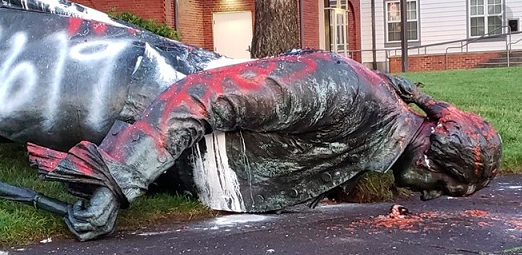Welcome to Byron York’s Daily Memo newsletter.
Was this email forwarded to you? Sign up here to receive the newsletter.
WHAT DO GEORGE WASHINGTON, THOMAS JEFFERSON, THEODORE ROOSEVELT, ULYSSES S. GRANT, FATHER JUNIPERO SERRA, AND CHRISTOPHER COLUMBUS HAVE IN COMMON? None was a Confederate general. And all have had their statues torn down by mobs in the last few days, or, in the case of Roosevelt, had New York’s Museum of Natural History announce that a Roosevelt statue at the museum’s entrance will soon be removed.
The mobs ripped down statues in Portland, San Francisco, Minneapolis, and other cities without any fear of police interference. The police might as well have been defunded, for all they did to protect America’s historical monuments from vigilante violence.

Subscribe today to the Washington Examiner magazine that will keep you up to date with what’s going on in Washington. SUBSCRIBE NOW: Just $1.00 an issue!
Back in August 2017, during a period in which activists sought the removal of statues of Confederal generals, President Trump made the classic slippery slope argument. “So this week, it’s Robert E. Lee,” he said. “I notice that Stonewall Jackson is coming down. I wonder, is it George Washington next week, and is it Thomas Jefferson the week after? You know, you really do have to ask yourself, where does it stop?”
A lot of people said that was ridiculous. The slippery slope argument “fails because there are obviously relevant distinctions that can be made between Washington and Jefferson on the one hand and Confederate leaders on the other,” wrote Ilya Somin in the Washington Post on August 15, 2017.
Tell that to the rope-wielding mobs seeking the next statue to pull down. Don’t you see there are relevant distinctions between Washington and Confederate leaders? In today’s mood, that argument is going exactly nowhere.
So what is next? More. After all, what is the disincentive for new mob attacks on historical monuments? Certainly not law enforcement. Yes, some of the more moderate-minded who supported the removal of Confederate statues are a bit embarrassed that the fire has spread to Washington, Jefferson, and beyond. But they can’t do anything to stop it.
And some influential voices seem quite happy with it. Consider this: Mob members sprayed graffiti all over the statue of George Washington brought down in Portland, Oregon. Among the graffiti: “1619.” That was a reference to the New York Times’ much-praised “1619 Project,” which sought to argue that the United States was not founded between 1776 and 1789, in the period from the Declaration of Independence to the ratification of the Constitution, but in 1619, with the arrival of the first Africans brought to Virginia to be sold as slaves. The Times “aims to reframe the country’s history, understanding 1619 as our true founding,” the paper said. According to the Times, the United States, beacon of democracy, freedom, and abundance, is in fact about racial injustice more than anything else.
So recently, noting the “1619” graffiti on the downed statue, the New York Post published an op-ed entitled “Call them the 1619 riots.” “America is burning,” author Charles Kesler said. “Looters have ravaged shops from coast to coast. And now, they’re coming for the statues — not just of Confederate generals, but the republic’s Founders, including George Washington…”
That caught the attention of the Times’ Nikole Hannah-Jones, creator of the “1619 Project.” Call them the 1619 riots? “It would be an honor,” she tweeted. “Thank you.” Hannah-Jones and the Times won the Pulitzer Prize for the “1619 Project.” The project’s lessons are being turned into a school curriculum. More honors certainly lie ahead.


